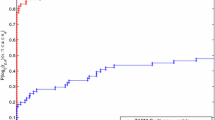Abstract
A new approach based on a global state space form is introduced for solving trajectory optimization problems with state inequality constraints via indirect methods. The use of minimal coordinates on a boundary arc of the state constraint eliminates severe problems, which occur for standard methods and are due to the appearance of differential-algebraic boundary-value problems. Together with a hybrid approach and a careful treatment of some interior-point conditions, we obtain an efficient and reliable solution method.
Similar content being viewed by others
References
Pesch, H. J., Off-Line and On-Line Computation of Optimal Trajectories in the Aerospace Field, Applied Mathematics in Aerospace Science and Engineering, Edited by A. Miele and A. Salvetti, Plenum Press, New York, New York, pp. 165–220, 1994.
Well, K. H., and Ebert, K., Trajectory Optimization Techniques and Software Implementation, Automatic Control in Aerospace 1992, Edited by D. B. DeBra and E. Gottzein, Pergamon, Oxford, England, pp. 77–87, 1993.
Hairer, E., and Wanner, G., Solving Ordinary Differential Equations, II: Stiff and Differential-Algebraic Problems, 2nd Edition, Springer, Berlin, Germany, 1996.
Brenan, K. E., Campbell, S. L., and Petzold, L., Numerical Solution of Initial-Value Problems in Differential-Algebraic Equations, 2nd Edition, SIAM, Philadelphia, Pennsylvania, 1996.
MÄrz, R., Numerical Methods for Differential Algebraic Equations, Acta Numerica, Edited by A. Iserles, Cambridge University Press, Cambridge, England, pp. 141–198, 1992.
Rentrop, P., Weiner, R., and Strehmel, K., Ein Überblick über Einschrittverfahren zur Numerischen Integration in der Technischen Simulation, GAMM Mitteilungen, Vol. 19, pp. 9–43, 1996.
Simeon, B., FÜhrer, C., and Rentrop, P., Differential-Algebraic Equations in Vehicle System Dynamics, Surveys on Mathematics for Industry, Vol. 1, pp. 1–37, 1991.
GÜnther, M., and Feldmann, U., CAD Based Electric Circuit Modeling in Industry, Part 1: Mathematical Structure and Index of Network Equations, Surveys on Mathematics for Industry, Vol. 8, pp. 97–129, 1999.
GÜnther, M., and Feldmann, U., CAD Based Electric Circuit Modeling in Industry, Part 2: Impact of Circuit Configurations and Parameters, Surveys on Mathematics for Industry, Vol. 8, pp. 131–157, 1999.
Kampowsky, W., Rentrop, P., and Schmidt, W., Classification and Numerical Simulation of Electric Circuits, Surveys on Mathematics for Industry, Vol. 2, pp. 23–65, 1992.
Gear, C. W., Differential-Algebraic Equations, Indices, and Integral Algebraic Equations, SIAM Journal on Numerical Analysis, Vol. 27, pp. 1527–1534, 1990.
Bryson, A. E., Denham, W. F., and Dreyfus, S. E., Optimal Programming Problems with Inequality Constraints, Part 1: Necessary Conditions for Extremal Solutions, AIAA Journal, Vol. 1, pp. 2544–2550, 1963.
Hartl, R. F., Sethi, S. P., and Vickson, R. G., A Survey of the Maximum Principles for Optimal Control Problems with State Constraints, SIAM Review, Vol. 37, pp. 181–218, 1995.
Eich, E., Mehlhorn, R., and Sachs, G., Stabilization of Numerical Solutions of Boundary-Value Problems Exploiting Invariants, Paper AIAA-94-3580-CP, Proceedings of the AIAA Guidance, Navigation, and Control Conference, 1994.
Shampine, L. F., Conservation Laws and the Numerical Solution of ODEs, Computers and Mathematics with Applications, Vol. 12, pp. 1287–1296, 1986.
MÄrz, R., Managing the Driftoff in Numerical Index-2 Differential Algebraic Equations by Projected Defect Corrections, Preprint 96-32, Institut für Mathematik, Humboldt Universität Berlin, 1996.
Gear, C. W., Maintaining Solution Invariants in the Numerical Solution of ODEs, SIAM Journal on Scientific and Statistical Computing, Vol. 7, pp. 734–743, 1986.
Ascher, U. M., and Petzold, L. R., Projected Implicit Runge-Kutta Methods for Differential-Algebraic Equations, SIAM Journal on Numerical Analysis, Vol. 28, pp. 1097–1120, 1991.
Bulirsch, R., and Chudej, K., Effiziente und stabile Lösung eines reichweiten-maximalen Fluges mit Staudruckbeschränkung für ein Überschallflugzeug, Paper DGLR-JT97-172, Deutscher Luft-und Raumfahrtkongress 1997, München, Germany, 1997.
Seywald, H., Cliff, E. M., and Well, K. H., Range-Optimal Trajectories for an Aircraft Flying in the Vertical Plane, Journal of Guidance, Control, and Dynamics, Vol. 17, pp. 389–398, 1994.
Miele, A., Flight Mechanics, Vol. 1: Theory of Flight Paths, Addison-Wesley, Reading, Massachusetts, 1962.
Raymer, D. P., Aircraft Design: A Conceptual Approach, American Institute of Aeronautics and Astronautics, Washington, DC, 1989.
Breitner, M. H., Numerische Berechnung der Barriere eines realistischen Differentialspiels, Diplomarbeit, Lehrstuhl für Höhere Mathematik und Numerische Mathematik, Technische Universität München, 1990.
Maurer, H., and Gillessen, W., Application of Multiple Shooting to the Numerical Solution of Optimal Control Problems with Bounded State Variables, Computing, Vol. 15, pp. 105–126, 1975.
Stragies, R., Numerische Berechnung des optimalen Reichweitenflugs für eine realistische Modellierung eines Überschallflugzeugs, Diplomarbeit, Lehrstuhl für Höhere Mathematik und Numerische Mathematik, Technische Universität München, 1996.
Chudej, K., Accelerating Multiple Shooting for State-Constrained Trajectory Optimization Problems, Variational Calculus, Optimal Control, and Applications, Edited by W. H. Schmidt, K. Heier, L. Bittner, and R. Bulirsch, Birkhäuser, Basel, Switzerland, pp. 197–206, 1998.
Chudej, K., Konvergenzbeschleunigung der Mehrzielmethode für Flugbahnopti-mierungsaufgaben, Zeitschrift für angewandte Mathematik und Mechanik, Vol. 78, pp. 879–880, 1998.
Von Stryk, O., and Bulirsch, R., Direct and Indirect Methods for Trajectory Optimization, Annals of Operations Research, Vol. 37, pp. 357–373, 1992.
Von Stryk, O., Numerische Lösung optimaler Steuerungsprobleme: Diskretisierung, Parameteroptimierung und Berechnung der adjungierten Variablen, Fortschritt-Berichte VDI, Reihe 8: Mess-, Steuerungs-und Regeltechnik, VDI Verlag, Düsseldorf, Germany, No. 441, 1995.
Bulirsch, R., Die Mehrzielmethode zur numerischen Lösung von nichtlinearen Randwertproblemen und Aufgaben der optimalen Steuerung, Report der Carl-Cranz-Gesellschaft, Oberpfaffenhofen, Germany, 1971.
Hiltmann, P., Numerische Lösung von Mehrpunkt-Randwertproblemen und Aufgaben der optimalen Steuerung mit Steuerfunktionen über endlichdimensionalen Räumen, Report 448, DFG-Schwerpunktprogramm Anwendungsbezogene Optimierung und Steuerung, Mathematisches Institut, Technische Universität München, 1993.
Hiltman, P., Chudej, K., and Breitner, M., Eine modifizierte Mehrzielmethode zur Lösung von Mehrpunkt-Randwertproblemen, Benutzeranleitung, Report 14, Sonderforschungsbereich 255, Transatmosphärische Flugsysteme, Lehrstuhl für Höhere Mathematik und Numerische Mathematik, Technische Universität München, 1993.
Schulz, V. H., Bock, H. G., and Steinbach, M. C., Exploiting Invariants in the Numerical Solution of Multipoint Boundary-Value Problems for DAEs, SIAM Journal on Scientific Computing, Vol. 19, p. 440–467, 1998.
Author information
Authors and Affiliations
Rights and permissions
About this article
Cite this article
Chudej, K., Günther, M. Global State Space Approach for the Efficient Numerical Solution of State-Constrained Trajectory Optimization Problems. Journal of Optimization Theory and Applications 103, 75–93 (1999). https://doi.org/10.1023/A:1021721316295
Issue Date:
DOI: https://doi.org/10.1023/A:1021721316295




